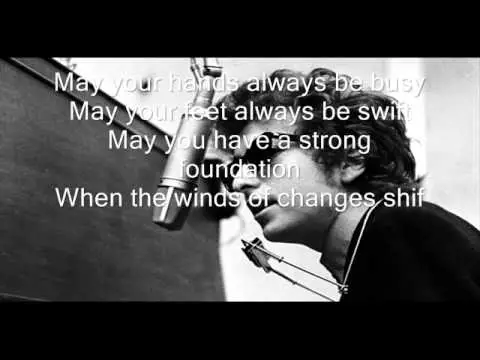Bob Dylan’s Influence: Shaping Folk Rock and Beyond

Bob Dylan forever young, born Robert Zimmerman in 1941 in Duluth, Minnesota, emerged as one of the most influential figures in American music. His journey began in the vibrant folk music scene of the early 1960s. Initially inspired by artists like Woody Guthrie and Leadbelly, Dylan’s music resonated with a generation grappling with social and political turmoil. He quickly rose to prominence, captivating audiences with his raw talent and poetic lyrics.
Dylan’s life was intertwined with the turbulent times of his era. He actively participated in the civil rights movement, composing protest songs like “Blowin’ in the Wind” and “The Times They Are a-Changin'”, which became anthems for the era. His music provided a voice to the marginalized, challenging societal norms and urging for change. However, Dylan’s artistic path wasn’t confined to the rigid confines of the folk genre. He evolved, continuously pushing boundaries and challenging preconceived notions. This evolution led him to embrace electric guitars, a move that initially alienated some of his folk purist fans but ultimately proved to be a pivotal moment in musical history.

The Life of Bob Dylan
Born as the second son of Abram Zimmerman and Beatty Stone, Robert Zimmerman grew up in a middle-class Jewish family. He had a relatively normal childhood, and it wasn’t until he attended college at the University of Minnesota that he discovered his passion for music. In college, he started performing at coffeehouses and soon dropped out to pursue a career in music.
Exploring the Collaboration Between Bob Dylan and The Band
In 1961, Dylan moved to New York City and began playing at Greenwich Village clubs, immersing himself in the thriving folk music scene. It was during this time that he changed his name to Bob Dylan, taking inspiration from the poet Dylan Thomas. He released his first album, “Bob Dylan”, in 1962, which featured traditional folk songs and a few original compositions. However, it wasn’t until his second album, “The Freewheelin’ Bob Dylan”, that he gained recognition for his songwriting abilities. This album included iconic songs like “Blowin’ in the Wind” and “A Hard Rain’s A-Gonna Fall”.
The Enduring Significance of Always on My Mind: A Song That Transcends Generations

Bob Dylan’s Enduring Legacy
Bob Dylan’s impact extends far beyond his music. His words and melodies have reverberated across generations, influencing countless artists and shaping the cultural landscape. He remains a towering figure in music, a voice that continues to inspire, challenge, and resonate with audiences worldwide.
His influence can be seen in the numerous cover versions of his songs by artists from diverse genres. From Jimi Hendrix’s electrifying rendition of “All Along the Watchtower” to Adele’s soulful interpretation of “Make You Feel My Love”, Dylan’s songs have been reimagined and rejuvenated time and again. Even decades after their release, his songs remain relevant and continue to be covered by popular artists.
In addition to musical influence, Dylan’s impact also extends to literature. He was awarded the Nobel Prize in Literature in 2016 “for having created new poetic expressions within the great American song tradition”. His lyrics are often considered poetry, with their vivid imagery and powerful storytelling. Many of his songs have been referenced and quoted in books, articles, and even political speeches, solidifying his place in literary history as well.
Exploring the Collaboration Between Bob Dylan and The Band

Exploring Bob Dylan’s Music Career
Over the course of his career, Bob Dylan has released 39 studio albums, 11 live albums, and over 70 singles. His discography is a testament to his versatility and evolution as an artist. While he is primarily known for his folk music, his sound has evolved over the years, incorporating elements of rock, blues, country, and even gospel.
Dylan’s early albums, like “The Freewheelin’ Bob Dylan” and “The Times They Are a-Changin'”, were heavily influenced by traditional folk songs and topical issues of the time. However, with his fifth album, “Bringing It All Back Home”, he began to experiment with electric instruments and rockabilly, much to the dismay of his folk purist fans. This move marked a significant shift in his sound and cemented his reputation as a pioneer in the folk-rock genre.
In the late 1960s, Dylan’s music took on a more introspective and personal tone, with albums like “Blood on the Tracks” and “Desire”. He also collaborated with The Band during this time, producing notable albums like “The Basement Tapes” and “Planet Waves”. In the 1970s and 1980s, Dylan continued to explore different genres, including gospel and blues, but also faced criticism for some of his artistic choices. However, his career took a resurgence in the 1990s with the release of albums like “Time Out of Mind” and “Love and Theft”, which received critical acclaim and reaffirmed Dylan’s position as a musical legend.

The Impact of Bob Dylan’s Lyrics
One of the most defining features of Bob Dylan’s music is his lyrics. His words are often poetic, thought-provoking, and full of imagery. They capture the essence of the human experience and transcend generations, making them timeless and relevant even decades after they were written.
Dylan’s lyrics often address social and political issues, reflecting the times he lived in. Songs like “Masters of War”, “Hurricane”, and “Idiot Wind” tackled topics like war, injustice, and societal hypocrisy. But his lyrics are not limited to just protest and political commentary. He also wrote about love, loss, and the complexities of relationships in songs like “Don’t Think Twice, It’s All Right” and “Tangled Up in Blue”.
His words have resonated with audiences worldwide and have been a source of inspiration for countless artists. Many of his lyrics are quoted and referenced in popular culture, demonstrating the lasting impact of his words.
Bob Dylan’s Influence on Folk Rock
Bob Dylan’s contribution to the folk-rock genre cannot be overstated. He was one of the first artists to merge the simplicity of folk music with the edginess of rock and roll, creating a new sound that struck a chord with audiences. His move towards electric guitars and rock-inspired arrangements not only expanded the boundaries of folk music but also paved the way for the emergence of other folk-rock artists like Simon Garfunkel and The Byrds.
Dylan’s influence can also be seen in his contemporaries, many of whom were inspired by his music. Artists like Joan Baez, Pete Seeger, and Judy Collins covered his songs, introducing them to a wider audience and helping to establish Dylan as a prominent figure in folk music.
Even after his initial shift towards folk-rock, Dylan continued to push boundaries and experiment with different sounds, never conforming to one particular style. This constant evolution and willingness to take risks have solidified his place as a pioneer and innovator in music.

Forever Young: A Song Analysis
One of Dylan’s most beloved songs is “Forever Young”, originally released on his 1974 album “Planet Waves”. The song has since been covered by numerous artists and has become an anthem for young people and parents alike.
The Lyrics
The song’s lyrics offer timeless advice and blessings to the listener, urging them to stay true to themselves and remain youthful at heart. In the chorus, Dylan sings:
May you stay forever young Forever young, forever young May you stay forever young
These lines are repeated throughout the song, emphasizing the sentiment of eternal youth. The verses of the song offer specific wishes for the listener, such as “May you grow up to be righteous, may you grow up to be true” and “May your hands always be busy, may your feet always be swift”. These wishes reflect Dylan’s hopeful and optimistic outlook on life, encouraging listeners to lead a fulfilling life and stay true to their values.

Interpretation and Meaning
While the song is often interpreted as a message from a parent to a child, it can also be seen as a universal message to all generations. The idea of staying forever young goes beyond just physical age; it speaks to the idea of keeping a youthful spirit and never losing the curiosity and wonder of childhood.
In an interview with Cameron Crowe in 1985, Dylan explained the meaning behind the song, saying, “The song is a prayer of sorts, I guess. It’s a statement that maybe you can say to make yourself feel better. It’s as if you were talking to yourself.”
This interpretation aligns with Dylan’s tendency to write introspective and personal songs, but it also speaks to the universality of his lyrics. “Forever Young” encapsulates the essence of Dylan’s music and its ability to resonate with audiences regardless of age or background.
Bob Dylan’s Timeless Appeal
One of the remarkable aspects of Bob Dylan’s music is its timeless appeal. Even after decades, his songs continue to captivate audiences and remain relevant. This is evident in the numerous awards and accolades he has received throughout his career. He has been inducted into the Rock and Roll Hall of Fame, Songwriters Hall of Fame, and has even received a Pulitzer Prize Special Citation “for his profound impact on popular music and American culture”.
His cultural significance extends beyond just music. In 2012, he was awarded the Presidential Medal of Freedom by former President Barack Obama, who described Dylan as “one of the most influential American musicians of the 20th century”. His music has also been featured in films, TV shows, and advertisements, solidifying his place as a cultural icon.

The Evolution of Bob Dylan’s Sound
Throughout his career, Bob Dylan has constantly evolved and experimented with different sounds, never conforming to one particular style. This evolution not only kept his music fresh and exciting but also allowed him to reach new audiences.
His early albums were heavily influenced by traditional folk songs, with simple acoustic arrangements. However, as he gained recognition and popularity, he began incorporating elements of rock and roll into his music. This shift towards electric guitars and fuller arrangements alienated some of his folk purist fans but also attracted a new audience.
In the 1980s, Dylan experimented with gospel and blues-inspired sounds, producing albums like “Slow Train Coming” and “Infidels”. While these albums received mixed reviews, they demonstrated Dylan’s willingness to take risks and explore different genres.
Even in his later years, Dylan continued to evolve, releasing critically acclaimed albums like “Time Out of Mind” and “Modern Times”, which featured a blend of blues, rock, and Americana. This versatility and constant experimentation have solidified Dylan’s status as a musical legend.

Interpreting the Meaning of ‘Forever Young’
The beauty of Bob Dylan’s lyrics is their open-endedness, allowing listeners to interpret them in their own way. “Forever Young” is no exception, with its simple yet profound message of staying true to oneself and remaining young at heart.
For some, the song may be seen as a parental blessing or a reminder to embrace youthfulness. For others, it may serve as a reminder to live life to the fullest and never lose sight of one’s dreams and passions. Regardless of interpretation, “Forever Young” has resonated with audiences worldwide, making it one of Dylan’s most beloved and timeless songs.
Bob Dylan’s Cultural Significance
Bob Dylan’s influence extends beyond just music. He is a cultural icon whose words and music have transcended generations, making him a voice for the people. His lyrics have been quoted and referenced in political speeches, books, and movies, demonstrating his impact on not just music, but also literature and popular culture.
Dylan’s involvement in social and political issues also adds to his cultural significance. He was an active player in the civil rights movement and has continued to use his platform to bring attention to important causes. In 2016, he released his 37th studio album, “Fallen Angels”, which included covers of classic American songs that were popular during the time of the Great Depression. This album paid tribute to the struggles of the working class and highlighted the ongoing issue of income inequality in America.

Conclusion
Bob Dylan’s journey from a young man performing in coffeehouses to a cultural icon has been nothing short of remarkable. He has pushed boundaries, challenged societal norms, and evolved as an artist, all while remaining true to his unique style and message. His impact on music and popular culture is undeniable, with his legacy continuing to inspire and resonate with audiences worldwide. As his iconic song “Forever Young” reminds us, may we all stay forever young, forever inspired by the music and words of Bob Dylan.

